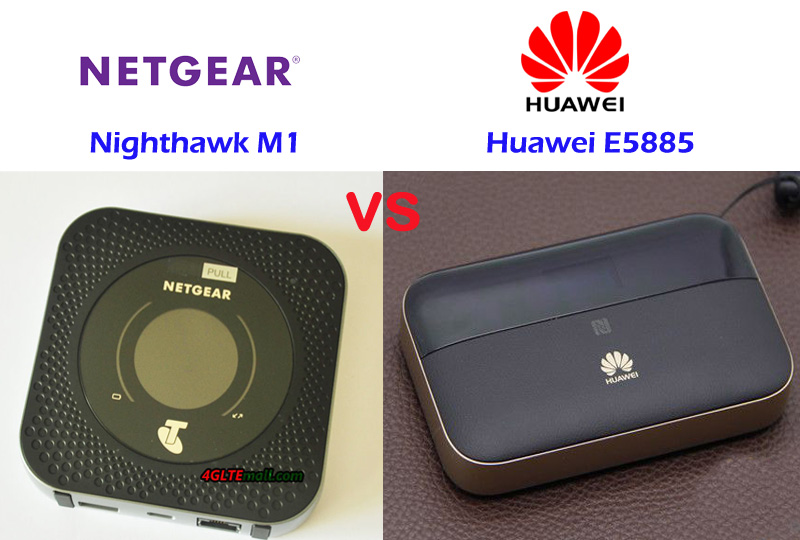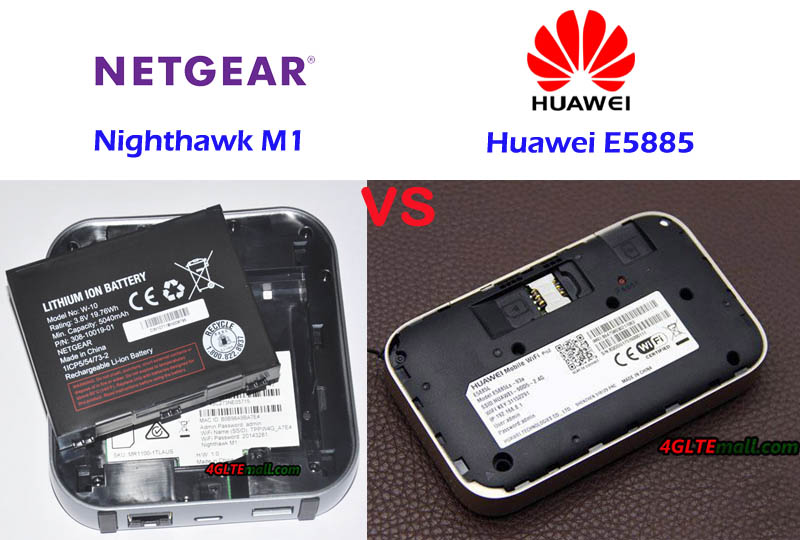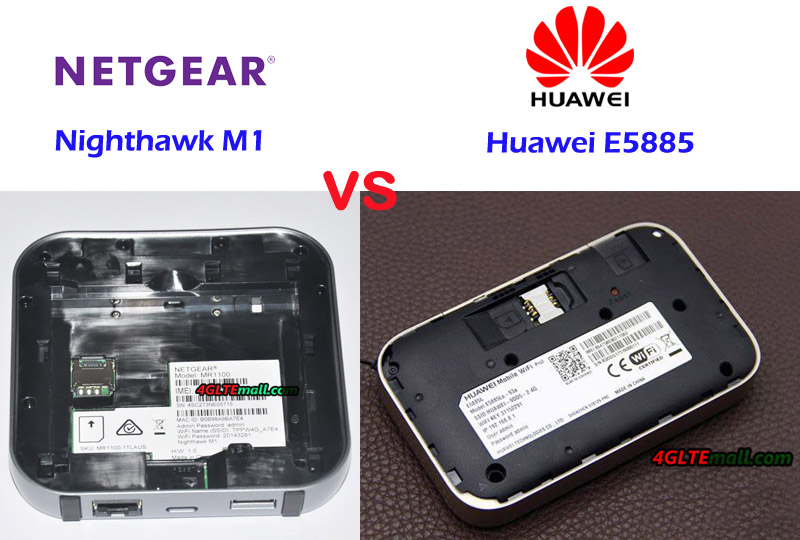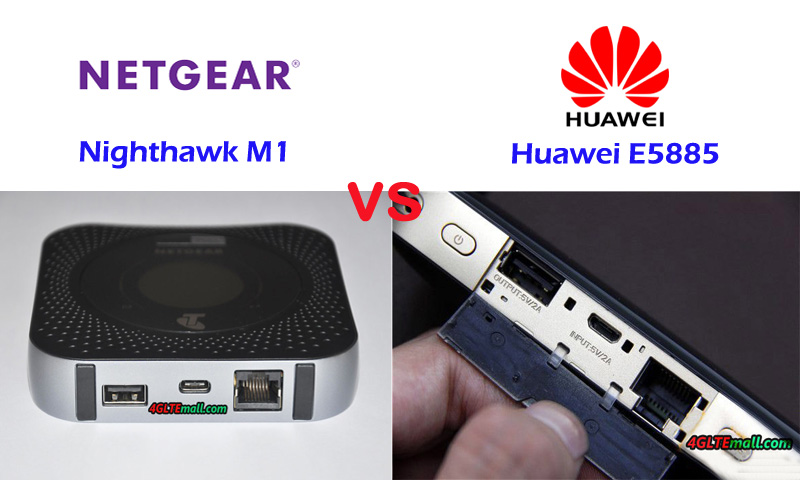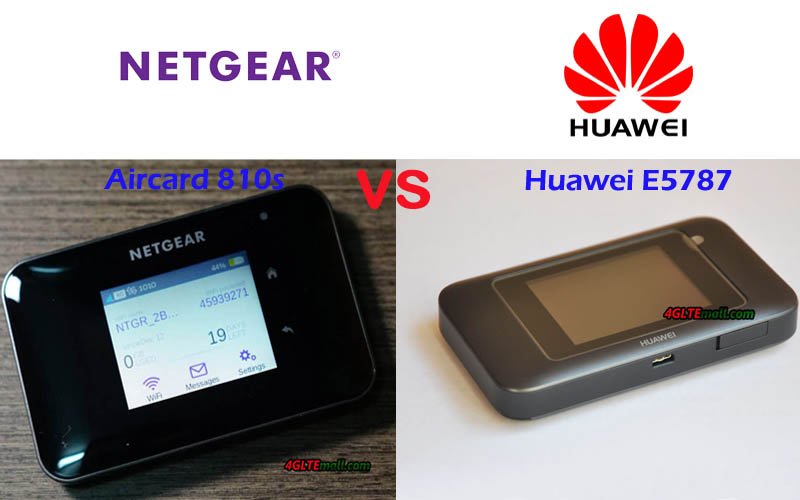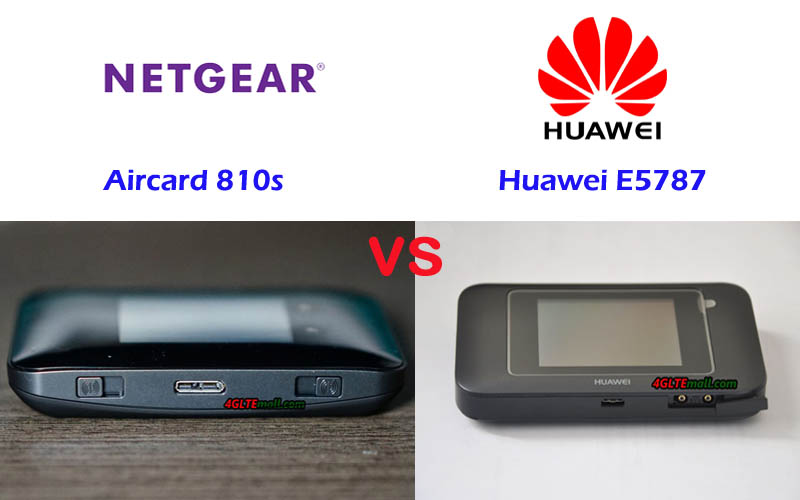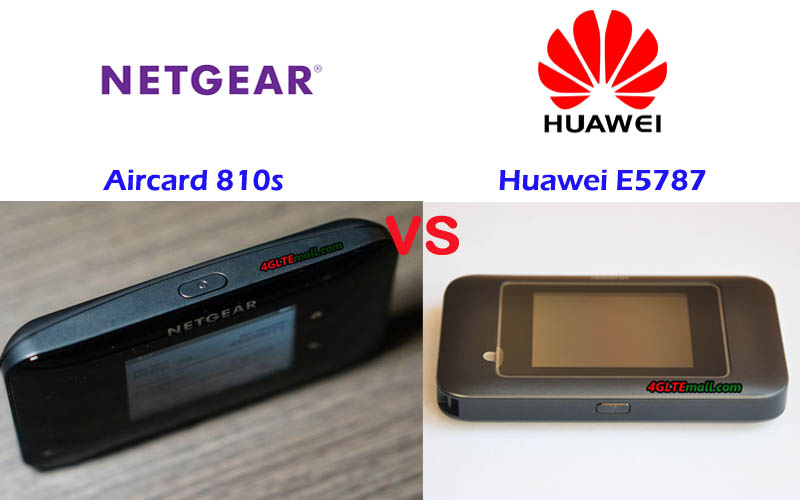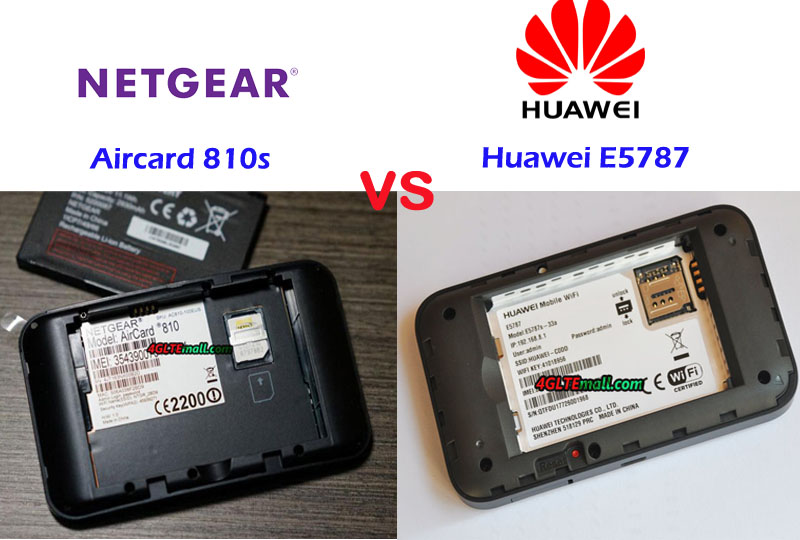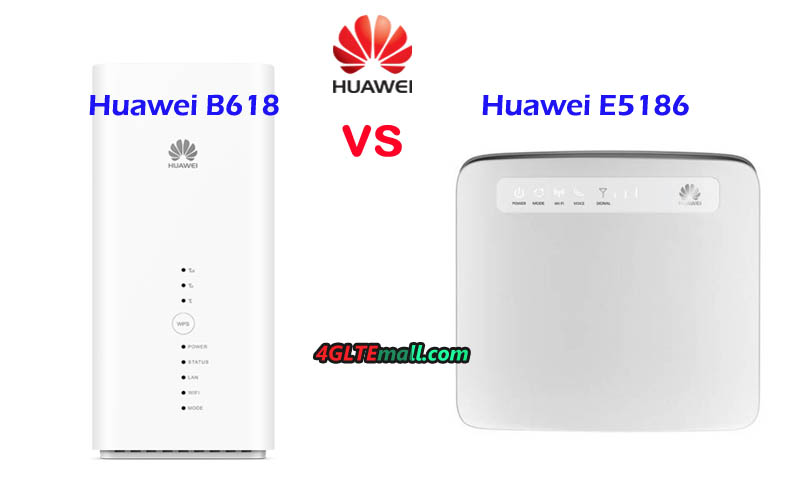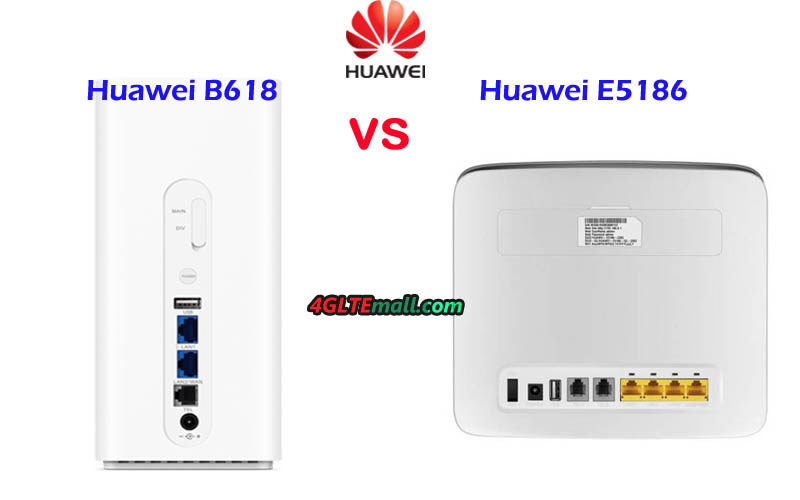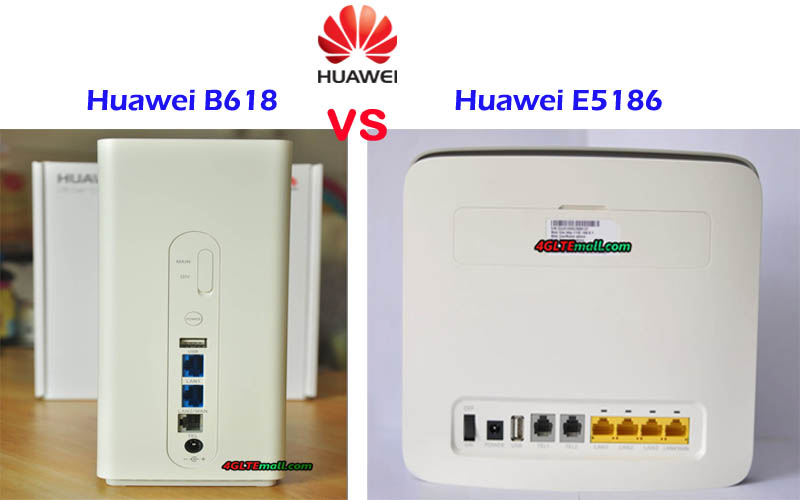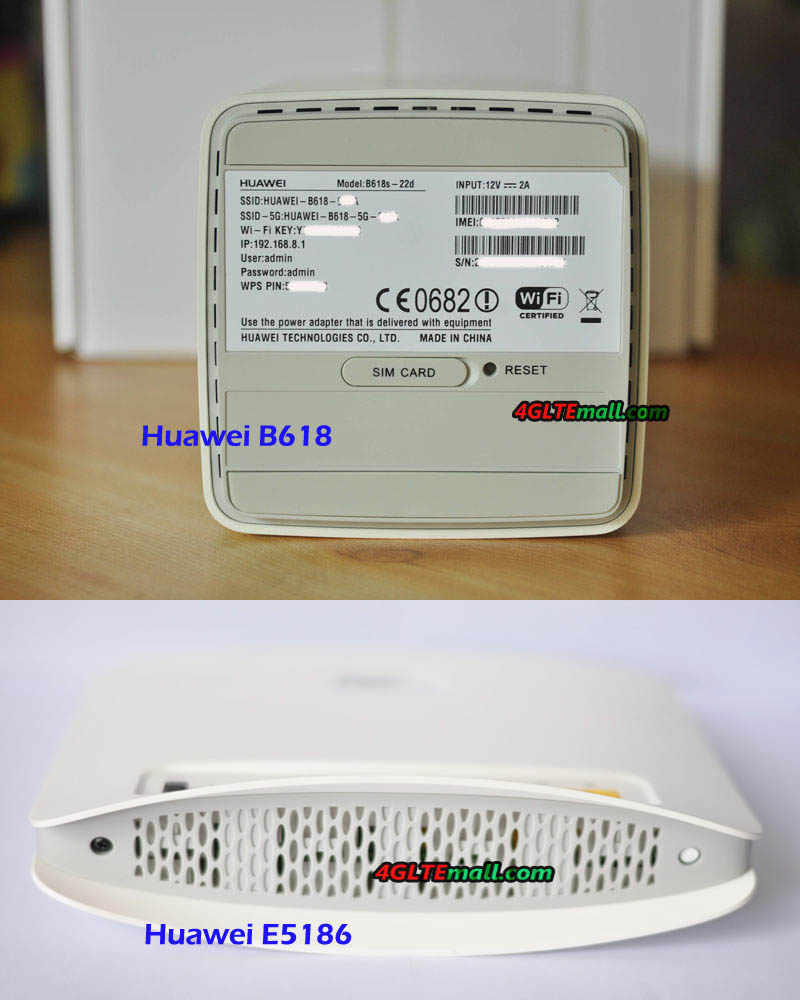huawei LTE modem
-
Netgear Nighthawk M1 Unlocked VS Huawei E5885Ls-93a
In past years, 4G mobile routers with SIM card slot are becoming more and more well-known because they are of small size and can be easily taken in a handbag or in a pocket. Nowadays, more and more people would prefer the 4G router with Ethernet port, which would provide one more option for internet connection. What's the most, the manufacturers typically set up the 4G routers with Ethernet with large battery pack, which makes the device more expensive. Huawei is the first manufacturer to release its 4G mobile router with Ethernet port, and now the Netgear follows. Huawei E5885 is the latest 4G mobile hotspot with Ethernet and Netgear presents the Nighthawk M1 as its first 4G router with Ethernet. Someone may ask: what's the difference between Huawei E5885 and Nighthawk M1? Which one is better? You may find the answers after reading this article.
Huawei E5885 Nighthawk VS M1 Appearance and Interface
Actually, before the Huawei E5885 was presented, Huawei had released a few mobile hotspots with Ethernet port such as E5151, E5730, E5351, E5770, E5771, which are a series of mobile routers with Ethernet. It has been proved this series of MiFi hotspots are very popular in the end-users. Now the upgraded Huawei E5885 is available with more advanced features and cool design. On the front of E5885, the upper part is LED screen while the lower part is leather material with Huawei logo. The touch feels much better than the predecessor models. And it's much thicker than the mobile hotspot E5770 and E5771. The power button, WPS, and the Interfaces are located on the top edge of the body. The Ethernet port and USB ports are covered by a square cap, which you have to open to see. The back cover could be removed, however, like the Huawei E5786, the battery is built-in and non-changeable. The Mirco SIM card slot and SD slot are available with the reset button.
Unlike its predecessor of Netgear mobile router, Nighthawk M1 also has a thick body. On the front, there is a round screen, like E5885, it's also not a touchscreen. There are battery and data transmission indicators around the screen. The Netgear logo and carrier logo are on the side of the screen. The power button is on the top and the Ethernet & USB ports are located on the opposite side. The difference is Netgear Nighthawk M1 has two connectors for external antenna, which is missing in Huawei E5885. And the USB ports for Nighthawk M1 and the Huawei E5885 are different. The Nighthawk M1 back cover could be removed and unlike Huawei E5885, the battery could also be removed for exchange. The Netgear M1 also uses Micro SIM card size, but no slot for SD card.
Netgear Nighthawk VS Huawei E5885 Specs and Variant Models
Since the nighthawk M1, AT&T Nighthawk M1, and another variant model for Europe market. The Huawei E5885 Huawei E5885Ls-93a. It seems to be a global version, however, in China, the Huawei E5885LS-93a in China has only one language (Chinese) available. In other countries such as Saudi Arabia or Romania, we found many languages available, at least with the English language. From the appearance, we can see the Nighthawk M1 and Huawei E5885 are very different in design. To know more difference, let's have a look at the detail specs of the Nighthawk M1 and E5885:
Model Netgear Nighthawk M1 Huawei E5885 Product type LTE Mobile Hotspot LTE Mobile Hotspot Category LTE Cat.16 LTE Cat.6 chipset Qualcomm MDM9x50 Hisilicon LTE Cat6 chipset Data rates DL 1Gbps / UL 100Mbps DL 300Mbps / UL 50Mbps Supported 4G LTE frequency bands - Telstra Nighthawk M1: Band 1/3/7/8/28
- AT&T Nighthawk M1: Band 1/2/3/4/5/7/12/29/30/66
- HK Nighthawk M1: Band 1/3/8/20/29/30/38/40/41
Huawei E5885Ls-93a: Band 1/2/3/4/5/7/8/19/20/28 * TDD-LTE: Band 38/40/41/42 WLAN 802.11a / b / g / n / ac, dual-band 2.4GHz & 5GHz 802.11a / b / g / n / ac, dual-band 2.4GHz & 5GHz Max support users 20 users 32 users MIMO 4 X 4 MIMO 2 X 2 MIMO Connector for external antenna Two, TS-9 jacks No connector Buy Antenna Netgear Nighthawk M1 Antenna N / A App management Netgear Aircard APP Huawei Hilink APP 3.0 SIM type Micro SIM Micro SIM Battery Removable, 5040 mAh Non-removable, 6400mAh Dimensions 105.5 x 105.5 x 20.35 mm 112.00 x 69.20 x 23.00mm Ethernet Port One Ethernet Port for LAN One port for WAN / LAN port (RJ-45) Datasheet download AT&T Nighthawk M1 Datasheet Huawei E5885 Datasheet User Manual AT&T Nighthawk M1 Manual Huawei E5885 Manual Other features 4 CA band, JumpBoost Power bank, CA, NFC Reviews Netgear Nighthawk AT&T M1 Review Huawei E5885Ls-93a Review Price 459.00USD 249.00USD Summary
From the specs, we can see the Nighthawk M1 Router is more advanced with the support of LTE Cat.16, which could achieve speeds up to 1Gigabit / s and upload speed to 100Mbps. The speed is much faster than that of Huawei E5885. The LTE Advanced Pro technologies would provide amazing surfing experience. The Nighthawk M1 variant models could be used globally after unlocking. However, there may be a limitation due to network incompatibility. The Huawei E5885LS-93a seems to be more open for global travel. It covers the main frequency bands in all areas.
The Nighthawk M1 could support up to 20 users while Huawei E5885 mobile hotspot supports up to 32 users. The Ethernet port in Huawei E5885 is for WAN and LAN but the port in Netgear M1 is only for LAN, which may not be expected for Ethernet. The Huawei E5885 has a large battery capacity of 6400mAh while Netgear MR100 has around 5040 mAh battery; However, the removable battery of Nighthawk M1 seems better than Huawei E5885 built-in battery. The lack of an antenna connector in Huawei E5885 is also criticized while the Netgear M1 has two connectors for external 4G antennas, which is very useful when using the device in weak signal areas. Per the feedback from the users of Nighthawk M1, it's the best 4G router with Ethernet. However, the advanced Nighthawk M1 is more expensive, so if you would buy Nighthawk M1, the price is an important concern.
PR -
Netgear Nighthawk M1 Unlocked VS Huawei E5885Ls-93a
In past years, 4G mobile routers with SIM card slot are becoming more and more well-known because they are of small size and can be easily taken in a handbag or in a pocket. Nowadays, more and more people would prefer the 4G router with Ethernet port, which would provide one more option for internet connection. What's the most, the manufacturers typically set up the 4G routers with Ethernet with large battery pack, which makes the device more expensive. Huawei is the first manufacturer to release its 4G mobile router with Ethernet port, and now the Netgear follows. Huawei E5885 is the latest 4G mobile hotspot with Ethernet and Netgear presents the Nighthawk M1 as its first 4G router with Ethernet. Someone may ask: what's the difference between Huawei E5885 and Nighthawk M1? Which one is better? You may find the answers after reading this article.
Huawei E5885 Nighthawk VS M1 Appearance and Interface
Actually, before the Huawei E5885 was presented, Huawei had released a few mobile hotspots with Ethernet port such as E5151, E5730, E5351, E5770, E5771, which are a series of mobile routers with Ethernet. It has been proved this series of MiFi hotspots are very popular in the end-users. Now the upgraded Huawei E5885 is available with more advanced features and cool design. On the front of E5885, the upper part is LED screen while the lower part is leather material with Huawei logo. The touch feels much better than the predecessor models. And it's much thicker than the mobile hotspot E5770 and E5771. The power button, WPS, and the Interfaces are located on the top edge of the body. The Ethernet port and USB ports are covered by a square cap, which you have to open to see. The back cover could be removed, however, like the Huawei E5786, the battery is built-in and non-changeable. The Mirco SIM card slot and SD slot are available with the reset button.
Unlike its predecessor of Netgear mobile router, Nighthawk M1 also has a thick body. On the front, there is a round screen, like E5885, it's also not a touchscreen. There are battery and data transmission indicators around the screen. The Netgear logo and carrier logo are on the side of the screen. The power button is on the top and the Ethernet & USB ports are located on the opposite side. The difference is Netgear Nighthawk M1 has two connectors for external antenna, which is missing in Huawei E5885. And the USB ports for Nighthawk M1 and the Huawei E5885 are different. The Nighthawk M1 back cover could be removed and unlike Huawei E5885, the battery could also be removed for exchange. The Netgear M1 also uses Micro SIM card size, but no slot for SD card.
Netgear Nighthawk VS Huawei E5885 Specs and Variant Models
Since the nighthawk M1, AT&T Nighthawk M1, and another variant model for Europe market. The Huawei E5885 Huawei E5885Ls-93a. It seems to be a global version, however, in China, the Huawei E5885LS-93a in China has only one language (Chinese) available. In other countries such as Saudi Arabia or Romania, we found many languages available, at least with the English language. From the appearance, we can see the Nighthawk M1 and Huawei E5885 are very different in design. To know more difference, let's have a look at the detail specs of the Nighthawk M1 and E5885:
Model Netgear Nighthawk M1 Huawei E5885 Product type LTE Mobile Hotspot LTE Mobile Hotspot Category LTE Cat.16 LTE Cat.6 chipset Qualcomm MDM9x50 Hisilicon LTE Cat6 chipset Data rates DL 1Gbps / UL 100Mbps DL 300Mbps / UL 50Mbps Supported 4G LTE frequency bands - Telstra Nighthawk M1: Band 1/3/7/8/28
- AT&T Nighthawk M1: Band 1/2/3/4/5/7/12/29/30/66
- HK Nighthawk M1: Band 1/3/8/20/29/30/38/40/41
Huawei E5885Ls-93a: Band 1/2/3/4/5/7/8/19/20/28 * TDD-LTE: Band 38/40/41/42 WLAN 802.11a / b / g / n / ac, dual-band 2.4GHz & 5GHz 802.11a / b / g / n / ac, dual-band 2.4GHz & 5GHz Max support users 20 users 32 users MIMO 4 X 4 MIMO 2 X 2 MIMO Connector for external antenna Two, TS-9 jacks No connector Buy Antenna Netgear Nighthawk M1 Antenna N / A App management Netgear Aircard APP Huawei Hilink APP 3.0 SIM type Micro SIM Micro SIM Battery Removable, 5040 mAh Non-removable, 6400mAh Dimensions 105.5 x 105.5 x 20.35 mm 112.00 x 69.20 x 23.00mm Ethernet Port One Ethernet Port for LAN One port for WAN / LAN port (RJ-45) Datasheet download AT&T Nighthawk M1 Datasheet Huawei E5885 Datasheet User Manual AT&T Nighthawk M1 Manual Huawei E5885 Manual Other features 4 CA band, JumpBoost Power bank, CA, NFC Reviews Netgear Nighthawk AT&T M1 Review Huawei E5885Ls-93a Review Price 459.00USD 249.00USD Summary
From the specs, we can see the Nighthawk M1 Router is more advanced with the support of LTE Cat.16, which could achieve speeds up to 1Gigabit / s and upload speed to 100Mbps. The speed is much faster than that of Huawei E5885. The LTE Advanced Pro technologies would provide amazing surfing experience. The Nighthawk M1 variant models could be used globally after unlocking. However, there may be a limitation due to network incompatibility. The Huawei E5885LS-93a seems to be more open for global travel. It covers the main frequency bands in all areas.
The Nighthawk M1 could support up to 20 users while Huawei E5885 mobile hotspot supports up to 32 users. The Ethernet port in Huawei E5885 is for WAN and LAN but the port in Netgear M1 is only for LAN, which may not be expected for Ethernet. The Huawei E5885 has a large battery capacity of 6400mAh while Netgear MR100 has around 5040 mAh battery; However, the removable battery of Nighthawk M1 seems better than Huawei E5885 built-in battery. The lack of an antenna connector in Huawei E5885 is also criticized while the Netgear M1 has two connectors for external 4G antennas, which is very useful when using the device in weak signal areas. Per the feedback from the users of Nighthawk M1, it's the best 4G router with Ethernet. However, the advanced Nighthawk M1 is more expensive, so if you would buy Nighthawk M1, the price is an important concern.
-
Sierra Wireless LTE Modules(EM Series, MC Series, HL Series) List
Sierra Wireless AirPrime LTE Cellular Modules
Sierra Wireless provides series of AirPrime LTE module for M2M wireless connectivity for worldwide use and various network. And the Sierra Wireless AirPrime modules are divided into AirPrime EM series, MC Series, HL Series and WP Series.
The Sierra AirPrime EM/MC Series LTE modules are ideal for industrial M2M and mobile computing solutions. with a wide selection of advanced air interfaces and/or with the support of LTE Advanced and carrier aggregation technology, AirPrime EM/MC Series embedded cellular modules could deliver high-speed connectivity based on the PCI Express M.2 standard with USB 3.0 and USB 2.0 interfaces or PCI Express Mini Card standard with a USB 2.0 interface. The Sierra EM/MC series 4G embedded modules offer an easy upgrade path to new network technologies and global access to high-speed networks.
The Sierra AirPrime® HL Series 4G LTE modules are the smallest, scalable, flexible solution in a compact and easy-to-integrate form factor that is completely interchangeable among 2G, 3G, and 4G technologies. Compact form factor, network scalability, and ready-to-use firmware upgrades make these LTE wireless modules ideal for industrial M2M solution designs where size and size are important considerations.
Sierra Wireless AirPrime EM Series, MC Series, HL Series, WP Series Module ListModelCategory Form Factor LTE Frequency BandsPeak SpeedTarget RegionPriceSpecsSierra AirPrime EM7565 LTE Cat.12 M.2 B1, B2, B3, B4, B5, B7, B8, B9, B12, B13, B18, B19, B20, B26, B28, B29, B30, B32, B41, B42 *, B43 *, B46 *, B48 *, B66 DL 600Mbps / UL 150Mbps Global (Planned: AT & T, Verizon, docomo, Telstra, Vodafone, Softbank, KDDI, Sprint) $ 379.00 EM7565 Specs Sierra AirPrime EM7511 LTE Cat.12 M.2 LTE: B1, B2, B3, B4, B5, B7, B8, B9, B12, B13, B14, B18, B19, B20, B26, B29, B30, B32, B41, B42, B46, B48, B66 DL 600Mbps / UL 150Mbps Americas (Planned: AT & T, Verizon) $ 399.00 EM7511 Specs Sierra AirPrime EM7455 LTE Cat.6 M.2 LTE-A: B1-B5, B7, B8, B12, B13, B20, B25, B26, B29, B30, B41 DL 300Mbps / UL 50Mbps Americas / EMEA (AT & T, Bell, Rogers, Sprint, TELUS, US Cellular, Verizon, Vodafone) $ 199.00 EM7455 Specs Sierra AirPrime EM7430 LTE Cat.6 M.2 LTE-A: B1, B3, B5, B7, B8, B18, B19, B21, B28, B38-B41 DL 300Mbps / UL 50Mbps APAC (docomo, Telstra, KDDI, Softbank) $ 229.00 EM7430 Specs Sierra AirPrime EM7445 LTE Cat.6 M.2 LTE-A: B1, B2, B3, B4, B5, B7, B8, B13, B17, B18, B19, B20, B25, B26, B29, B30, B38, B41 DL 300Mbps / UL 50Mbps Americas (Planned: AT & T, Verizon, Sprint) $ 159.00 EM7445 Specs Sierra AirPrime EM7440 LTE Cat.6 M.2 LTE-A: B1, B2, B3, B5, B7, B8, B11, B18, B19, B20, B21, B25, B26, B28, B38, B39, B40, B41 DL 300Mbps / UL 50Mbps EMEA / Australia (Orange, Telefonica, Telstra, Vodafone) $ 199.00 EM7440 Specs Sierra AirPrime EM7305 LTE Cat.3 M.2 LTE: B1, B3, B7, B8, B20 DL 100Mbps / UL 50Mbps EMEA / Australia (Orange, Telefonica, Telstra, Vodafone) $ 159.00 EM7305 Specs Sierra AirPrime EM7355 LTE Cat.3 M.2 LTE: B2, B4, B5, B13, B17, B25 DL 100Mbps / UL 50Mbps Americas (AT & T, Bell, Rogers, Sprint, Telus, T-Mobile, Verizon) $ 159.00 EM7355 Specs Sierra AirPrime EM7345 LTE Cat.3 M.2 B1, B2, B3, B4, B5, B7, B8, B13, B17, B18, B19, B20 DL 100Mbps / UL 50Mbps Americas (Planned: AT & T, Verizon) $ 189.00 EM7345 Specs Sierra AirPrime EM7340 LTE Cat.3 M.2 B1, B3, B8, B9, B18, B19, B21, B26 DL 100Mbps / UL 50Mbps APAC (docomo, KDDI) $ 239.00 EM7340 Specs Sierra AirPrime EM7330 LTE Cat.3 M.2 B1, B19, B21 DL 100Mbps / UL 50Mbps EMEA / Australia (Telstra, Vodafone) $ 259.00 EM7330 Specs Sierra AirPrime EM7700 LTE Cat.3 M.2 B4, B17 DL 100Mbps / UL 50Mbps Americas (AT & T) $ 129.00 EM7700 Specs Sierra AirPrime MC7700 LTE Cat.3 PCIe M.2 B4, B17 DL 100Mbps / UL 50Mbps Americas (AT & T, Docomo NTT,
Bell, Telus, Roger)$ 149.00 MC7700 Specs Sierra AirPrime MC7304 LTE Cat.3 PCIe M.2 B1, B3, B7, B8, B20 DL 100Mbps / UL 50Mbps EMEA / Australia (Telstra, Vodafone) $ 189.00 MC7304 Specs Sierra AirPrime MC7305 LTE Cat.3 PCIe M.2 B1, B3, B7, B8, B20 DL 100Mbps / UL 50Mbps EMEA / Australia (Telstra, Vodafone) $ 199.00 MC7305 Specs Sierra AirPrime MC7330 LTE Cat.3 PCIe M.2 B1, B19, B21 DL 100Mbps / UL 50Mbps APAC (docomo, KDDI) $ 189.00 MC7330 Specs Sierra AirPrime MC7355 LTE Cat.3 PCIe M.2 B2, B4, B5, B13, B17, B25 DL 100Mbps / UL 50Mbps Americas (AT & T, Bell, Rogers, Sprint, Telus, T-Mobile, Verizon) $ 159.00 MC7355 Specs Sierra AirPrime MC7350 LTE Cat.3 PCIe M.2 B4, B13, B25 DL 100Mbps / UL 50Mbps Americas (Sprint, Verizon) $ 229.00 MC7350 Specs Sierra AirPrime MC7350L LTE Cat.3 PCIe M.2 B4, B13 DL 100Mbps / UL 50Mbps $ 279.00 MC7350L Specs Sierra AirPrime MC7354 LTE Cat.3 PCIe M.2 B2, B4, B5, B13, B17, B25 DL 100Mbps / UL 50Mbps Americas (AT & T, Bell, Rogers, Sprint, Telus, T-Mobile, Verizon) $ 239.00 MC7354 Specs Sierra AirPrime MC7430 LTE Cat.6 PCIe M.2 LTE-A: B1, B3, B5, B7, B8, B18, B19, B21, B28, B38-B41 DL 300Mbps / UL 50Mbps APAC (docomo, Telstra, KDDI, Softbank) $ 229.00 MC7430 Specs Sierra AirPrime MC7455 LTE Cat.6 PCIe M.2 LTE-A: B1-B5, B7, B8, B12, B13, B20, B25, B26, B29, B30, B41 DL 300Mbps / UL 50Mbps Americas / EMEA (AT & T, Bell, Rogers, Sprint, TELUS, US Cellular, Verizon, Vodafone) $ 249.00 MC7455 Specs Sierra AirPrime MC7710 LTE Cat.3 PCIe M.2 B1, B3, B7, B8, B20 DL 100Mbps / UL 50Mbps EMEA / Australia (Telstra, Vodafone) $ 129.00 MC7710 Specs Sierra AirPrime MC7750 LTE Cat.3 PCIe M.2 B13 DL 100Mbps / UL 50Mbps Verizon $ 129.00 MC7750 Specs Sierra AirPrime WP7700 LTE Cat-M1 / NB1 LGA B1, B2, B3, B4, B5, B8, B12, B13, B17, B18, B19, B20, B26, B28 Cat-M1: DL 300kbps / UL 375Mbps
Cat-NB: DL 27kbps / UL 65KbpsGlobal (Planned: AT & T, Verizon, LGU +) $ 149.00 WP7700 Specs Sierra AirPrime WP7702 LTE Cat-M1 / NB1 LGA B1, B2, B3, B4, B5, B8, B12, B13, B17, B18, B19, B20, B26, B28 Cat-M1: DL 300kbps / UL 375Kbps
Cat-NB: DL 27kbps / UL 65KbpsGlobal (Planned: AT & T, Verizon, LGU +) $ 149.00 WP7702 Specs Sierra AirPrime WP7601-1 LTE Cat.1 LGA B4, B13 DL 10Mbps / UL 5Mbps Americas (Verizon) $ 99.00 WP7601-1 Specs Sierra AirPrime WP7603-1 LTE Cat.1 LGA B2, B4, B5, B12 DL 10Mbps / UL 5Mbps Americas (AT & T) $ 99.00 WP7603-1 Specs Sierra AirPrime WP7607-1 LTE Cat.1 LGA B1, B3, B7, B8, B20, B28 DL 10Mbps / UL 5Mbps EMEA $ 99.00 WP7607-1 Specs Sierra AirPrime WP7608-1 LTE Cat.1 LGA B1, B3, B5, B8, B40, B41 * DL 10Mbps / UL 5Mbps India, China $ 99.00 WP7608-1 Specs Sierra AirPrime WP7502 LTE Cat.3 LGA B1, B3, B7, B8, B20 DL 100Mbps / UL 50Mbps EMEA $ 129.00 WP7502 Specs Sierra AirPrime WP7504 LTE Cat.3 LGA B2, B4, B5, B12, B17, B25, B26 DL 100Mbps / UL 50Mbps Americas (AT & T, Sprint) $ 129.00 WP7504 Specs Sierra AirPrime WP7504-1 LTE Cat.3 LGA B2, B4, B5, B12, B17, B25, B26 DL 100Mbps / UL 50Mbps Americas (AT & T) $ 129.00 WP7504-1 Specs Sierra AirPrime WP7601 LTE Cat.4 LGA B4, B13 DL 150Mbps / UL 50Mbps Americas (Verizon) $ 149.00 WP7601 Specs Sourcing from https://www.4gltemall.com/m2m-lte-module/sierra-wireless-airprime-module.html
-
Difference between Netgear AC810S and Huawei E5787
Netgear 4G mobile routers are very well-known worldwide due to the stable performance and practical functions, and it’s always leading the development direction of the 4G LTE mobile broadband. If you know the Netgear Aircard 790s, you may know it’s the world’s first LTE mobile hotspot with a touchscreen. Now the upgraded model Aircard 810s becomes the best seller for LTE-A networks. As the aggressive competitor, Huawei follows the steps of Netgear. Huawei released its first LTE mobile router with a touchscreen: Huawei E5787 (also named Huawei Mobile WiFi Touch). And now the market proves the Huawei E5787 also becomes the best seller of Huawei LTE hotspot with a touchscreen. Someone may ask: What’s the difference between Huawei E5787 and Netgear Aircard 810s? Which one is better? You will find one answer in this article.
Huawei E5787 VS Netgear Aircard 810s Appearance and Interface
The Huawei E5787 and Netgear Aircard 810s both have a touchscreen in the middle of the front. Netgear aircard 810 has a Home button and Back button at the side of the screen. However, the Huawei E5787 doesn’t have the button. Only Huawei logo is below the screen. They have the same features on the appearance: the power button is at the top edge side of the router, on the opposite side, two TS-9 connectors for external antennas are available, and they both have USB 3.0 interface. The difference is the Huawei E5787 antenna connectors located together while the Aircard 810s antenna connectors are located separately, the USB 3.0 interface is in the middle of the two connectors.
The battery of Netgear AC810s and Huawei E5787 could be removed for exchange, and they both use Micro SIM card. However, they both don’t have the slot for Micro SD storage card. Huawei E5787 has a special design: one corner of the body has a port to tie a rope so that you can hold the rope to keep the Huawei E5787 device.
Netgear AC810S VS Huawei E5787 Specs and Variant models
From the appearance and interfaces, we can see the design of the Huawei E5787 and Aircard 810s is very similar, especially when they are both in black color. The Huawei E5787 has other colors available in the market, such as Glod, White, Brown etc… Like other Huawei 4G Mobile WiFi Hotspots, Huawei E5787 also has many variant models: Huawei E5787s-33a, Huawei E5787Ph-67a, and Huawei E5787Ph-92a. Similarly, the Aircard 810s has two variant models: one for Telstra and the other for Europe. Then let’s review the Huawei E5787 specs and Aircard 810s specs for more comparison:
Model Huawei E5787 Netgear Aircard 810s Product type LTE Mobile Hotspot LTE Mobile Hotspot Category LTE Cat.6 LTE Cat.11 Chipset HiSilicon LTE Cat6 Chipset Qualcomm Snapdragon X12 Data rates DL 1Gbps/UL 100Mbps DL 600Mbps/UL 100Mbps Supported 4G LTE frequency bands * Huawei E5787s-33a: Band 1/3/5/7/8/20/38/40/41 * Huawei E5787Ph-67a: Band 1/3/5/7/8/20/38/40/41 B1, B3, B7, B8, B28 WLAN 802.11a/b/g/n/ac, dual-band 2.4GHz & 5GHz 802.11a/b/g/n/ac, dual-band 2.4GHz & 5GHz Max support users 10 users 15 users MIMO 2 X 2 MIMO 2 x 2 MIMO Connector for external antenna Two, TS-9 jacks Two, TS-9 jacks Buy Antenna Huawei E5787 external Antenna Aircard 810s External Antenna App management Huawei Hilink APP Netgear Aircard APP SIM type Micro SIM Micro SIM Battery 3000mAh 2930 mAh Dimensions 109.00 x 58.00 x 7.50mm 112 x 68.6 x 15.45mm Ethernet Port No No Datasheet download Huawei E5787 Datasheet Netgear AC810S Datasheet User Manual Huawei E5787 Manual Telstra 4GX Adavanced III Manual Other features 2 band CA 3 band CA Reviews Huawei E5787 Review Netgear Aircard 810s review Price 299.00USD 229.00USD Summary
From the specs, we can see the Aircard 810s is more advanced than the Huawei E5787, because the Netgear 810S could support maximum downloads speed up to 600mbps while the E5787 support peak downlink speed to 300Mbps. The Aircard 810s can achieve twice faster speed than that of E5787. It’s probably because of the Qualcomm chipset with more advanced technologies. And Netgear Aircard 810s supports more WiFi users to 15 while Huawei E5787 4G+ supports only 10 users. However, the Huawei E5787 has more variant models, which means the sub-models could work well with more LTE network providers. The unlocked version would travel globally freely.
The amazing thing is that the more advanced mobile hotspot Netgear Aircard 810s has a better price than that of Huawei E5787. With more powerful function and better price, if you would buy a 4G pocket WiFi router for global use, the Aircard 810s would be the better option than Huawei E5787.
-
Huawei B618 VS Huawei E5186 - Which 4G SIM Router is better?
Since Huawei LTE router WiFi is very popular in the global market, if you want to buy a 4G SIM router for home or office, you may consider Huawei LTE routers such as Huawei B618 or predecessor model Huawei E5186. But what’s the difference between the Huawei E5186 router and B618 CPE? And which one is better to buy? The questions would be answered in this article.
Huawei E5186 VS B618 CPE Appearance and Interfaces
If you had used a Huawei 4G router, you may know the Huawei E5186 router, which is the best seller of 4G LTE-A router from Huawei. It’s in white color and in a traditional router design. On the front, there are five indicators on the front for Power, Mode, WiFi, Voice, and Signal. On the back, there are 4 Ethernet Ports for LAN (One is for LAN & WAN), two Telephone ports and one USB 2.0 port. The Huawei B618 4G LTE router is the latest new LTE advanced Pro router, which is in a new design of a Cube in white color. It also has some indicators on the front vertically for Signal, Power, Status, LAN, WiFi, Mode, among which the WPS buttons are available.
The Huawei B618 Router also has the Ethernet ports on the back, but there are only two LAN port, one of which is for both LAN and WAN. Only one telephone port is available below the Ethernet port. The USB 2.0 port is above the Ethernet port. The power button and connectors for external 4G Antennas are available on the Ethernet and USB ports. The connector type is TS-9. If you need Huawei B618 antenna, you must buy an LTE Antenna with two TS-9 connectors. The Huawei E5186 also has two connectors for an external antenna on the back covering a long cap. The connector type is SMA-Female. If you need Huawei E5186 external antenna, you must buy an LTE antenna with two SMA connectors.
Huawei B618 VS E5186 Specs and Variant models
If you had some blogs about 4G LTE devices, you may know that the many LTE devices have variant models to support various LTE frequency bands over the world. To support these LTE bands, Huawei E5186 router has two variant models E5186s-22a and E5186s-61a. The Huawei B618 also has two sub-models: B628s-22d and B618s-65d. From the appearance, we can only see the difference is in the design and Ethernet ports. Regarding the data transmission performance and other features, you may check the table for Huawei E5186 specs and Huawei B618 specs:
Model Huawei B618 Huawei E5186 Product type LTE WiFi Router LTE WiFi Router Category LTE Cat.9/ Cat.11 LTE Cat.6 Chipset HiSilicon Balong 750 HiSilicon LTE Cat6 Chipset Data rates DL 600Mbps/UL 100Mbps DL 300Mbps/UL 50Mbps Supported 4G LTE frequency bands Huawei B618s-22d: Band 1/3/7/8/20/38 Huawei B618s-65d: 1/3/5/7/8/28/40 Huawei E5186s-22a: Band 1/3/7/8/20/38 Huawei E5186s-61a: Band 3/7/28/40 WLAN 802.11a/b/g/n/ac, dual-band 2.4GHz & 5GHz 802.11a/b/g/n/ac, dual-band 2.4GHz & 5GHz Max supported users 64 users 64 users MIMO 4 X 4 MIMO 2 x 2 MIMO Connector for external antenna Two, TS-9 jacks Two, SMA-female jacks Buy Antenna Huawei B618 Antenna Huawei E5186 external antenna App management Huawei Hilink APP Huawei Hilink APP SIM type Micro SIM Micro SIM Battery NO NO Dimensions 95mm × 95mm × 208mm 190 mm × 200 mm × 32 mm Interfaces * 1 x LAN port(45) * 1 x LAN/WAN port (45) * 1 x telephone port(RJ11) * 1 x USB 2.0 port * 3 x LAN port(45) * 1 x LAN/WAN port (45) * 2 x telephone port(RJ11) * Two external LTE antenna ports (SMA-J1.5) * One micro-SIM card slot * 1 x USB 2.0 port Datasheet Huawei B618 Datasheet Huawei E5186 Datasheet(PDF) User Manual Huawei B618 User Manual Huawei E5186 User Manual(PDF) Other features DHCP Server, DNS RELAY and NAT, VoLTE, IPv4 /IPv6 dual stack Firewall, CS Voice, VoIP, TR069 Remote Management, HTTP Online Upgrade, QoS, USB Share, UPnP, IPV6, DLNA, Fax, Print, VPN Reviews Huawei B618s-22d Review Huawei E5186 Review Price/USD 449.00USD 259.00USD Summary
From the specs table, we can see the Huawei B618 router is more advanced than unlocked Huawei E5186 router. LTE CPE B618 could support downlink speed up to 600Mbps with 4 x 4 MIMO technology, which is almost double faster than that of Huawei E5186. The two variant models of the two routers cover similar LTE frequency bands, which mean they are designed for same areas. However, the advanced Huawei B618 has fewer Ethernet interfaces than Huawei E5186. If you would use the router with more than 2 devices through Ethernet port, you’d better select the Huawei E5186 as a home or office router. However, if you use the router mainly through WiFi, the Huawei B618 router would be very good. Since the two Huawei Routers would provide wireless internet for up to 64 users, Huawei B618 provider fast internet speeds.
Of course, the Huawei B618 provide faster speeds with advanced technologies, the price would be more expensive than Huawei E5186 router. So if you don’t have enough budget for B618 CPE, the Huawei 5186 is recommended, in our test, it’s good enough for most cases in our daily life.

